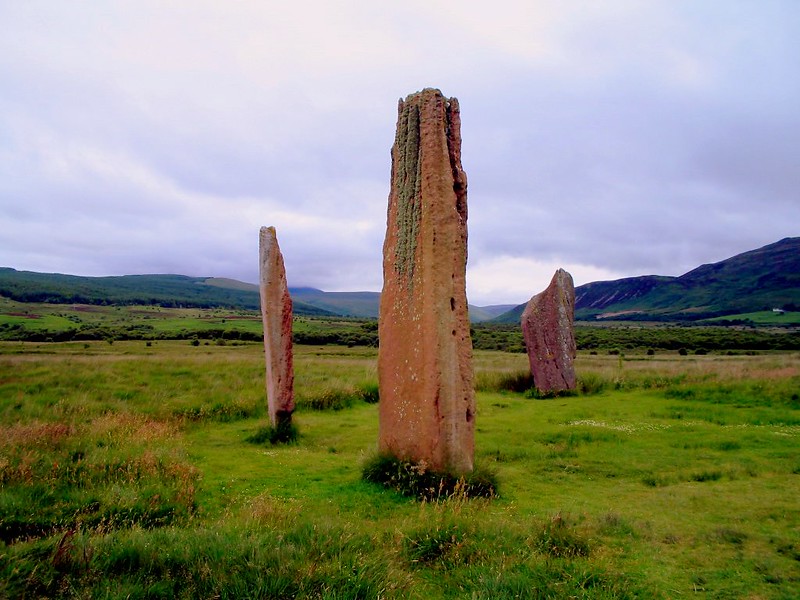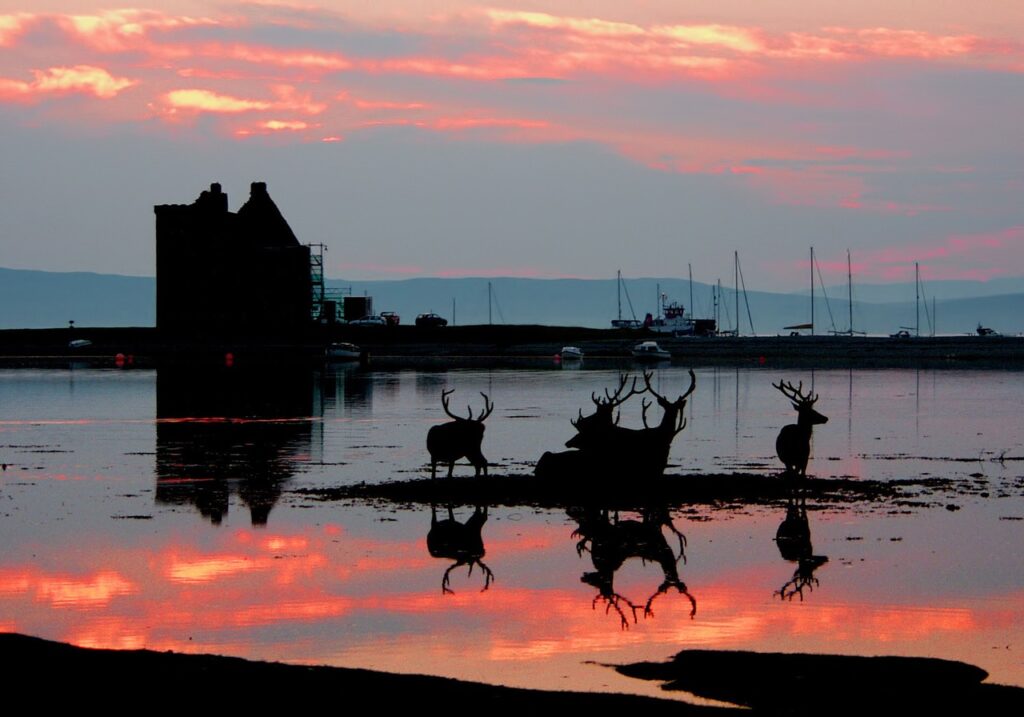
Image by Jocelyn Durston. CC / Flickr
It happened the year the vernal equinox fell in the middle of our college’s spring break. That was the year the English Heritage Society denied my request to allow our group of college students and staff to walk among the stones of Stonehenge at sunset after the throngs of visitors had left for the day. It had become a tradition on our annual leadership trip to Europe. That particular week, however, the site belongs to the thousands who gather to connect with their druid and pagan ancestors in celebration of spring.
I am not sure how it’s become embedded in their mindset, but Stonehenge appears to be the raison d’etre for millennials visiting the UK. Consequently, I spent hours fishing in Google for another stone circle that might compare to the quixotic Stonehenge and provide enough surrounding attractions that would appeal to a group of 18 to 20-year-old college students on a spring holiday from classes. And that’s when I discovered Machrie Moor on the Isle of Arran, 450 miles north of the Salisbury plains, off coast of western Scotland. In a matter of seconds, I located Arran on Google Earth, zooming in to examine the landscape, and marveling that some tech-savvy wayfarer had left a digital footprint–images of obscure red stones, tall and out of place, in the middle of a vivid green meadow.

Soon, a new route took shape that included a moonlight train ride across the countryside from London to Glasgow on the Caledonian Sleeper, a forty-minute chartered coach ride to Ardrossan’s harbor, and an hour’s passage on a Caledonian MacBrayne ferry. The beauty and warm welcome we found on this small island is a subject for a much longer story. Often called “Scotland in Miniature,” Arran features picturesque lowlands and majestic peaks in an area no greater than thirty miles in length. A two-lane highway winds around its circumference, revealing the serenity of rural living with thriving villages and remnants of lives past including the ruins of Lochranza Castle on the southern tip.
Although Brodick and Lamlash on the island’s east shore serve as the primary travel hub and business center with the majority of the island’s nearly 5000 inhabitants, I booked two nights for our group on the far side of the island. The Kinloch is one of the larger hotels although it’s located in Blackwater Foot, home to scarcely more than 50 people. Upon arrival in the late afternoon, room keys were quickly assigned to our group of 30, and to almost everyone’s delight, most rooms faced Drumadoon Bay with its rock-strewn beach and a haunting view of Kilbrannon Sound beyond. We gathered downstairs before our splendid evening meal in the hotel’s restaurant, and most of us made our way to the beach, coatless in the chilly March air, to witness the magic of a Scottish sunset. Golden hues of red then pink cast a shimmering reflection across the calm sea before disappearing all together.

But poetry nor pictures describe the experience the following afternoon, the first golden day of spring, when we found our way to several of the six rings that comprise Machrie Moor. For those who have the leisure time to spare, Machrie Moor car park is a mere three-mile hike from the Kinloch along A841, a quiet rural paved road. However, with a single day to explore only a few of the island’s many other attractions—the Arran Distillery and Brodick Castle, for example– I persuaded the driver I hired to chauffeur our group through Scotland, to get us as far as the car park. With the help of Google maps, I estimated the walk along the public access path to the stones to be nearly two miles, a fact confirmed by the proprietor of the hotel.
I made it clear the hike to the stone circle excursion was strictly optional and those willing to spend an afternoon traipsing alongside grazing sheep should meet after lunch in the hotel lobby. To my surprise, shy of four female students, the entire group was waiting in the lobby when I arrived. Many had extra jackets or rain gear and a water bottle in tow. A few even had brightly colored wellies they purchased at a store in Brodick that morning. For a moment I worried that as the weeks had unfolded, I had set expectations too high with my promise of “adventure,” wandering through the Arran countryside in search of a pseudo Stonehenge. After all, so little has been written about Machrie Moor—there are many such circles across the wide expanse of Scotland. And, furthermore, the little things that excite me don’t seem to have the same effect on others. But as we all piled in the bus, my husband beside me and my cheerful co-colleague in the seat in front of us, those worries subsided. It was a carefree afternoon, several thousand miles from home, and we were blissfully intoxicated by the fresh sea air and the sun just peaking out of the clouds after an overcast morning of intermittent drizzle.

Like the nearly 1300 other stone circles documented across Great Britain, historians can’t confirm with certainty the reason Machrie Moor’s circles were constructed, but believe they are connected to religious rituals involving the alignment of the sun and the moon. In particular, Machrie’s stones appear to be strategically placed to capture the sun’s intersection at sunrise each year during the fleeting summer solstice. First recorded by Irish geologist James Bryce in 1861, the oldest stones may have replaced circles and huts of timber dating back 3500 years B.C. As an explanation for sandstone pillars in one circle and white granite stones in another, site excavators have concluded the circles may have evolved over hundreds of years as one generation of Arran’s earliest inhabitants made way for the next. Today, no circle is completely intact, some of the stones likely carted off over the centuries for other primitive building endeavors.
In our two-mile hike along the grassy public path, that afternoon was strangely charmed. We had left central Missouri with memories of a long frigid winter and remnants of snow, but spring had arrived on Arran—warm, bright and glorious. Sweaters and jackets came off and were tied about the waist as the clouds drifted farther from the sun. Small clusters of students formed as they made their way along the path and happy voices mingled with laughter. Some raced ahead and some lagged behind, but all were caught up in the joy of nature renewed with the simple arrival of spring.
Several in the small circle that formed around me spoke of their Scottish heritage—the region from which their family originated or the year they immigrated–small bits of information passed down by grandparents and great-grandparents. Sadly, I and many students claim Scottish roots, but too many generations separate us from the details of their lives. What were their joys? What were their sorrows? As we pondered these questions for an hour or so, it was easy to imagine we were walking in the footsteps of our ancestors –no cell phones, laptops or television– trusting only in the elements of nature like those who came before us—the sweet songs of the birds, the fresh smell of green Scottish fields.

When we eventually reached the tallest stones, we discovered that only three remained upright— motionless giants, nearly twice as tall as we were. Brilliant rays of sun beat down on these silent pillars, clearly out of place with the flat green landscape that loomed before us. Graduated hills of lavender were visible in the distance and beyond them rose a range of peaks. Goat Fell Mountain, Arran’s tallest peak, stood distinctly above the rest.
We stood for a long time studying the stones and relishing the landscape, not ready to leave. The solemnity of the moment was broken when we noticed not forty yards away, a gang of sheep had come as close as the fence would allow and studied us as intently as if they were the humans and we were their subjects. We laughed, of course, and many photos were snapped. Some made vows to return one day with future mates or children not yet born. Although most had been strangers months before the trip, there was a sense we were now a tightly knit group of friends bonded by many days of traveling and especially by this one golden moment on this first day spring on Machrie Moor.
It was a perfect moment, my favorite moment as a teacher, and I think of it often.
